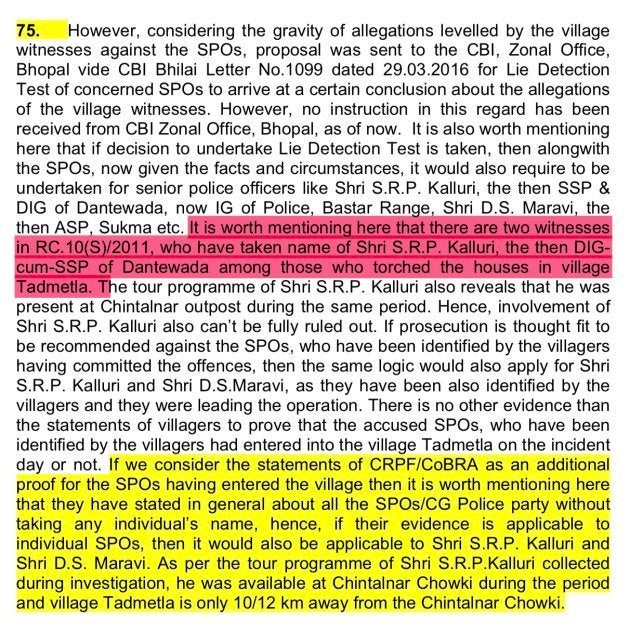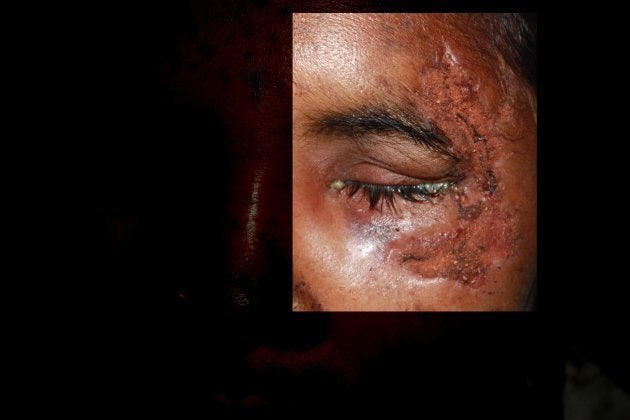
NEW DELHI — The Central Bureau of Investigation (CBI) dropped the testimonies of key witnesses, ignored its own findings and withheld critical information from the Supreme Court in a 2011 case accusing the Chhattisgarh police of burning over 300 homes, killing three men and raping three women in the course of a counter-insurgency operation in 2011, according to an internal memo leaked to HuffPost India.
The memo, HuffPost India learnt, was intended as the basis for the CBI's chargesheets and closure reports submitted to a Raipur special court in October 2017, as part of a Supreme Court monitored investigation into human rights violations in Chhattisgarh.
The memo was shared with HuffPost India as allegations of corruption within the CBI, traded between the CBI's former Director Alok Verma and his deputy Rakesh Asthana, has resulted in the disclosure of key information that had been suppressed in the course of its investigations.
HuffPost India has written to the CBI and will update the story once the agency replies.
The CBI's actions in such a sensitive case offer fresh evidence that the institution described as both India's premier investigative agency and a "caged parrot", can't always be trusted with cases that prove inconvenient to its political masters.
The closure reports were submitted to the Special Judicial Magistrate, CBI Raipur in 2017, when the Bharatiya Janta Party (BJP) was in power in the centre and in Chhattisgarh — a situation that continues to this day.
Report versus memo
A comparison of the closure reports filed by the agency to the court, and the internal memo, shows the following discrepancies:
- The closure report chargesheets four junior policemen, but dropped the testimonies of two witnesses [HuffPost India is redacting their names to protect them from reprisals] who said Inspector General SRP Kalluri was present at the site when his forces allegedly ran amok and burnt the Tadmetla village. Kalluri is a controversial police officer who headed anti-Maoist operations in Bastar until he was sidelined in 2017.
- The memo quotes official logs that indicate that Kalluri was present at a police base less than 10 km from the scene of the crime and there are no logs to indicate his further movements."The tour programme of Shri S.R.P. Kalluri also reveals that he was present at Chintalnar outpost during the same period," the memo states. "Hence, involvement of Shri S.R.P. Kalluri also can't be fully ruled out. If prosecution is thought fit to be recommended against the SPOs, who have been identified by the villagers having committed the offences, then the same logic would also apply for Shri S.R.P. Kalluri and Shri D.S.Maravi, as they have been also identified by the villagers and they were leading the operation."

- The closure reports do not include the testimony of a CPRF trooper, recorded in the memo, who said, "when the police party was returning from village Tadmetla, he saw the police party taking two civilians seeming to be villagers along with them. Some old women along with children of village Tadmetla were also following the police personnel who picked up the villagers with them."
The closure report said the CBI could not find evidence to support the testimony of a woman who said she was raped by Special Police Officers, as they could not find biological evidence or witnesses to support the charge. The internal memo agrees with these findings, but offers more details and context than the version submitted to the court.
The memo states: "Though the allegations of rape is proved by the statement of the victim herself, by corroboration of the fact of injury mark near eye available on [Redacted], by corroboration of the fact that she was lying unconscious, but as no individual responsible for the stated offence of rape could be identified, hence, no further action can be taken in this matter."
Here's a photograph that this reporter took of the victim in March 2011, days after the police operation.

The closure report reproduces a First Information Report, filed by the police, that claims that the villages were burnt, and villagers attacked, when 100 to 150 Maoists ambushed a police party, and concludes that further investigations are required.
The memo, includes the testimonies of 18 CRPF troopers who said they did not hear any gunshots — from Maoist or policeman — despite being present at the spot.
"In such a situation where many of the security personnel is unaware about any firings/gunshots, there are high possibility of there being no encounter with any naxals." the memo concludes.
Chilling lapses
Perhaps the most chilling aspects of the memo touch upon what passes for standard operating procedure in Chhattisgarh.
The Chhattisgarh police, the CBI found, "could not submit the details of arms and ammunition issued to all the police force who had participated in the operation."
"This is really a very worrisome fact and has got serious ramification, where there is no strict accounting and the government is not sure about the exact number of ammunitions issued to its personnel. This could even lead to illegal trading of ammunitions to the very perpetrators of naxalism and terrorism."
Further, the inquiry found that the Chhattisgarh police had given the CBI an incomplete information on the number of police officers who participated in the raids.
"The FIR of RC.08(S)/2011 mentions the number of security personnel as 340 and the FIR of RC.11(S)/2011 mentions the number of security personnel as 327, who had participated in the operation, yet the police has furnished list of only 323 personnel," the memo states.
The implications are profound, as the memo notes, "There is a possibility of commission of crime by those personnel, whose names are not reflected in the official records and yet remain away from clutches of law as no record would show their names for having participated in the operation under question."
The Tadmetla Case
In 2011, this reporter and Anil Mishra, a reporter with Rajasthan Patrika at the time, reported on the aftermath of a scorched-earth counter-insurgency operation by the Chhattisgarh police in Bastar's Konta block, that ended with three villages in flames, three alleged deaths, and three alleged rapes.
When the Chhattisgarh police attacked convoys of relief materials headed for the affected villages, the matter was brought to the Supreme Court who directed the CBI to investigate the matter in July that year. The matter was taken up sociologist Nandini Sundar, who was already fighting a on-going case on the constitutionality of counter-insurgency operations in Chhattisgarh, particularly the deployment of civilian vigilantes in the Salva Judum.
In the course of its investigation, the CBI's investigating team was itself attacked by the Chhattisgarh police to stymie the investigation. In October 2016, the agency filed a set of closure reports that downplayed most of its findings and focused on punishing junior policemen rather than focussing on the IPS officers who planned the operation.